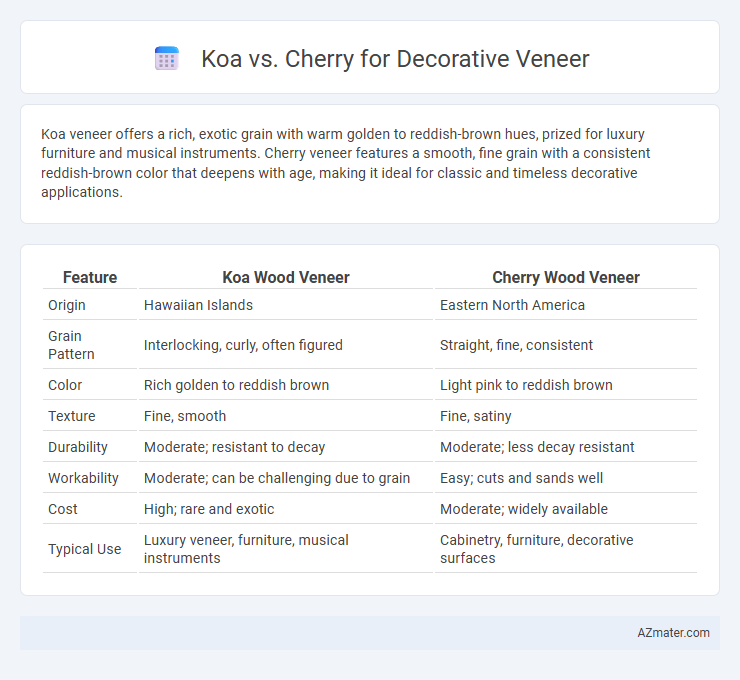Koa veneer offers a rich, exotic grain with warm golden to reddish-brown hues, prized for luxury furniture and musical instruments. Cherry veneer features a smooth, fine grain with a consistent reddish-brown color that deepens with age, making it ideal for classic and timeless decorative applications.
Table of Comparison
| Feature | Koa Wood Veneer | Cherry Wood Veneer |
|---|---|---|
| Origin | Hawaiian Islands | Eastern North America |
| Grain Pattern | Interlocking, curly, often figured | Straight, fine, consistent |
| Color | Rich golden to reddish brown | Light pink to reddish brown |
| Texture | Fine, smooth | Fine, satiny |
| Durability | Moderate; resistant to decay | Moderate; less decay resistant |
| Workability | Moderate; can be challenging due to grain | Easy; cuts and sands well |
| Cost | High; rare and exotic | Moderate; widely available |
| Typical Use | Luxury veneer, furniture, musical instruments | Cabinetry, furniture, decorative surfaces |
Introduction to Decorative Veneers
Decorative veneers are thin slices of wood applied to surfaces for aesthetic enhancement and durability, with Koa and Cherry being popular choices due to their unique grain patterns and color tones. Koa veneer offers rich, varied hues ranging from golden to reddish-brown with striking curly figure, often prized in high-end furniture and musical instruments for its visual appeal. Cherry veneer is valued for its smooth, fine grain and warm, reddish-brown color that darkens gracefully over time, making it a versatile option for elegant cabinetry and interior design.
Overview of Koa and Cherry Wood
Koa wood, native to Hawaii, is highly valued for its rich, golden to reddish-brown hues and striking grain patterns, making it a premium choice for decorative veneer applications. Cherry wood, predominantly sourced from North America, offers a smooth texture and warm, reddish-brown color that deepens with age, providing classic elegance in veneer projects. Both woods exhibit durability and a fine finish, but Koa's exotic appeal contrasts with Cherry's traditional and versatile aesthetic in interior design.
Appearance and Grain Patterns
Koa veneer showcases a rich, golden to reddish-brown color with striking curly and wavy grain patterns that create a dynamic, warm aesthetic ideal for high-end decorative applications. Cherry veneer features a smooth, uniform texture with fine, straight to slightly wavy grain and a warm, reddish tone that deepens over time, offering a classic and elegant appearance. Choosing between Koa and Cherry depends on the desired visual impact: Koa delivers vibrant, exotic character while Cherry provides refined, timeless beauty.
Durability and Hardness Comparison
Koa veneer exhibits moderate hardness with a Janka rating of approximately 1,560, offering good durability for interior decorative applications. Cherry veneer, with a slightly lower Janka hardness of around 950, is softer but still provides adequate wear resistance for furniture and paneling. Both woods offer excellent aesthetic appeal, though Koa's higher hardness makes it more suitable for surfaces requiring greater scratch and dent resistance.
Workability and Finishing Qualities
Koa offers excellent workability due to its moderate density and fine, interlocking grain, allowing for smooth sanding and detailed carving without chipping. Cherry is also highly workable, with a straight grain that machines well and responds favorably to hand tools, making it a popular choice for fine woodworking. In terms of finishing, Koa's natural luster and rich color deepen beautifully with oil finishes, while Cherry darkens uniformly over time, providing a warm, polished look with stains and clear coats.
Cost and Availability
Koa veneer is prized for its rich, warm tones and intricate grain patterns but often comes with a higher price tag due to limited supply and slow growth rates, making it less readily available. Cherry veneer offers a more affordable option with consistent availability, featuring a smooth texture and a reddish-brown hue that deepens over time. Choosing between Koa and Cherry veneers depends largely on budget constraints and the need for immediate procurement, with Cherry being the cost-effective and widely accessible choice.
Sustainability and Environmental Impact
Koa veneer, sourced primarily from Hawaiian Acacia trees, offers a sustainable choice when harvested through certified reforestation programs that ensure minimal environmental disruption. Cherry veneer, typically derived from American Cherry trees, supports sustainability by being a fast-growing hardwood with widespread availability, reducing pressure on old-growth forests. Both veneers contribute to eco-friendly applications when sourced responsibly, with koa emphasizing unique regional conservation efforts and cherry benefiting from extensive sustainable forestry management.
Best Applications in Interior Design
Koa veneer, prized for its rich, warm tones and striking grain patterns, is ideal for luxury furniture, wall paneling, and accent pieces that demand a natural, tropical aesthetic. Cherry veneer offers a smooth texture and a consistent reddish-brown hue, making it perfect for classic cabinetry, flooring, and refined millwork in traditional or modern interiors. Both veneers enhance interior design with durability and elegance, but Koa suits high-end, exotic themes while Cherry complements versatile, timeless environments.
Maintenance and Longevity
Koa veneer offers a rich, warm appearance with moderate maintenance requirements, needing regular cleaning and occasional refinishing to preserve its durability and luster. Cherry veneer, known for its smooth grain and deepening color over time, demands careful upkeep to avoid dents and scratches, but it typically ages gracefully, improving in character with minimal intervention. Both veneers provide long-lasting beauty when properly maintained, but Koa's harder surface may offer slightly better resistance to wear under heavy use.
Choosing Between Koa and Cherry for Your Project
Koa offers a unique, highly figured grain pattern and rich golden-brown hues that deepen with age, making it ideal for luxurious, statement decorative veneer projects. Cherry provides a smooth, consistent grain with warm reddish tones and excellent workability, favored for classic, elegant finishes requiring durability. Selecting between koa and cherry hinges on your desired aesthetic impact and project environment, with koa suited for bold, high-end designs and cherry preferred for timeless, versatile applications.

Infographic: Koa vs Cherry for Decorative Veneer
 azmater.com
azmater.com